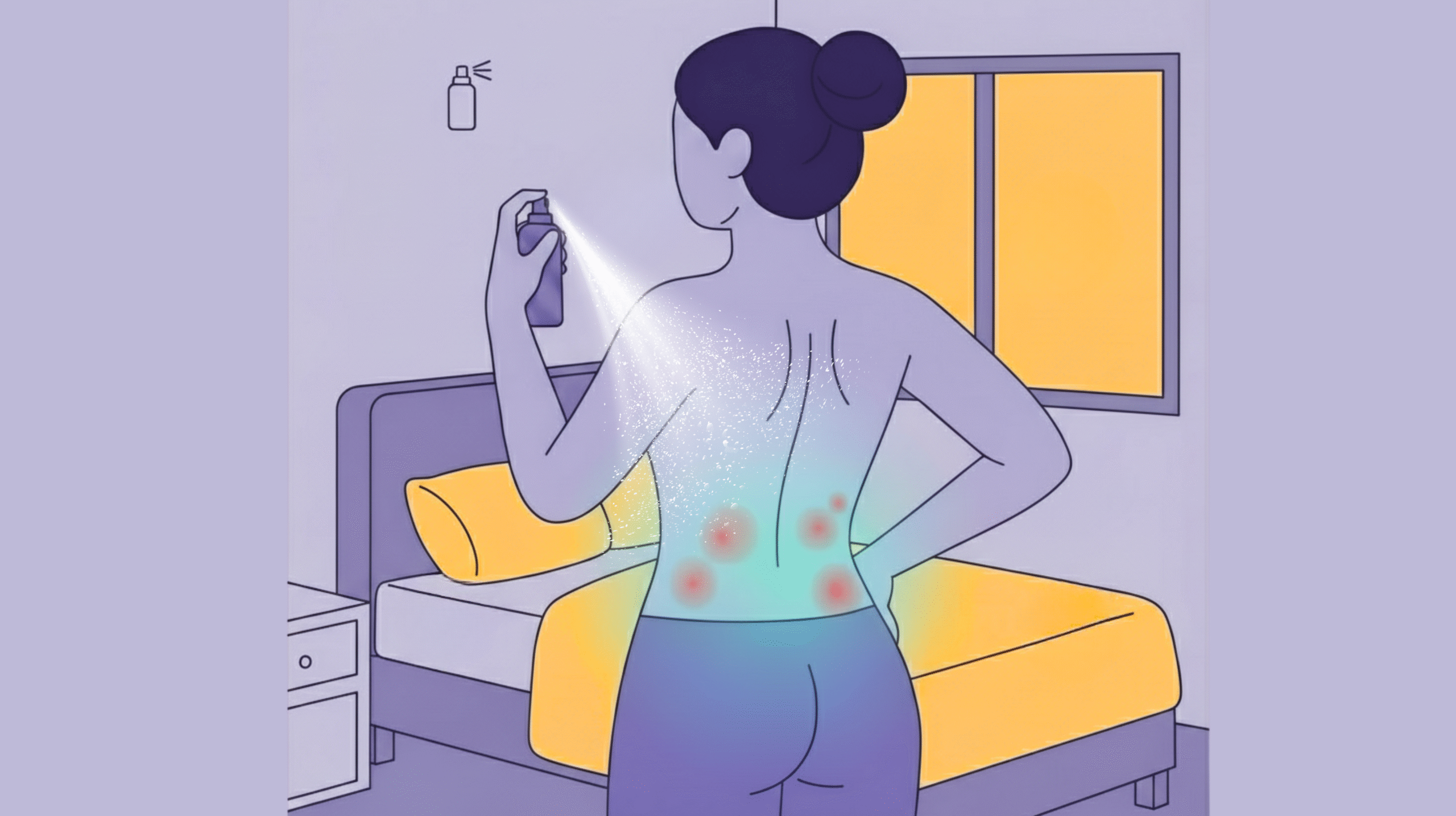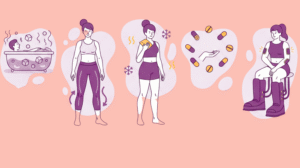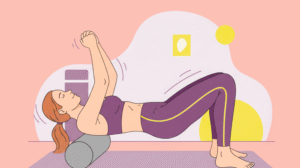Back pain is considered to be one of the greatest health issues worldwide, as millions of people of any age suffer from it. It may be due to accidents, bad posture, inactivity and aging that changes the spine. The major cause of disability in the world is lower back pain. It makes it difficult to do daily activities, work and enjoy life in general.
The back pain may be mild or very severe that it becomes impossible to perform the daily routine. Most of the population go through back pain at least once in their lifetime. Acute and chronic back pain are detrimental to sleep, movement abilities, and mental well-being.
Back pain is chronic and can complicate activities of individuals to perform daily tasks which results in absenteeism and loss of productivity in the workplace. In addition to that, painful experiences may aggravate the depressive, anxious, and stressed state of mind leading to a decreased level of life satisfaction.
Back pain sprays have gained popularity in the recent past due to their ability to act fast and easy to use. Sprays unlike the pills are directed to the skin itself providing direct relief to the ailing areas. They are safe, effective, and portable to use in the treatment of acute and chronic pains.
Understanding Back Pain
Common Causes of Back Pain
- Poor Posture: Slouching while sitting or standing puts undue stress on the spine and muscles.
- Injuries: Muscle strains, ligament sprains, or accidents can lead to acute back pain.
- Aging: Degenerative changes in spinal discs and joints contribute to chronic pain [1].
- Sedentary Lifestyle: Lack of physical activity weakens core muscles and increases susceptibility to pain.
Types of Back Pain
- Acute Back Pain: Sudden onset, often due to injury or heavy lifting; typically lasts less than six weeks.
- Chronic Back Pain: Persistent pain lasting more than three months, often linked to underlying conditions like arthritis, herniated discs, or nerve compression.
When to Seek Medical Advice vs. Self-Care Remedies?
Seek medical attention if back pain:
- Is severe or persistent.
- Radiates down the legs or causes numbness/tingling.
- Is accompanied by unexplained weight loss, fever, or bladder/bowel dysfunction.
Mild to moderate pain without alarming symptoms can often be managed with self-care, including back pain relief sprays, stretching, heat/cold therapy, and posture correction.
What is a back pain relief spray?
Definition and Purpose
A back pain relief spray is a topical product formulated to reduce discomfort in muscles, joints, and nerves. Sprays are designed for fast absorption into the skin, delivering active ingredients directly to affected areas.
How Pain Relief Sprays Work?
- Cooling Sprays: Contain menthol or camphor to produce a cooling sensation, soothing inflammation and swelling [2].
- Warming Sprays: Include capsaicin or similar agents to increase blood flow, relax tight muscles, and reduce stiffness.
- Anti-Inflammatory Sprays: Contain NSAIDs like diclofenac to block inflammation and provide analgesic effects.
Differences from Gels, Balms, and Oral Painkillers
- Gels & Balms: Require rubbing or massaging into the skin; slower absorption.
- Oral Painkillers: Systemic effects, may cause gastrointestinal or kidney issues with long-term use.
- Sprays: Quick application, targeted relief, minimal systemic absorption.
Key Ingredients in Back Pain Relief Sprays
1. Menthol and Camphor
- Provide a cooling effect, reduce pain perception, and relax muscles.
- Commonly used in over-the-counter sprays for acute muscle soreness.
2. Capsaicin
- Derived from chili peppers; produces a warming effect.
- Works by desensitizing nerve endings, reducing the transmission of pain signals.
3. Diclofenac and NSAID-Based Sprays
- Provide anti-inflammatory effects, reducing swelling and pain.
- Often used for chronic conditions like arthritis or tendonitis.
4. Essential Oils
- Peppermint, Eucalyptus, Lavender: Offer mild analgesic and anti-inflammatory properties [3].
- Also provide soothing aromatherapy benefits.
5. Ayurvedic and Herbal Ingredients
- Turmeric, Ashwagandha, Arnica: Traditional ingredients with anti-inflammatory and muscle-relaxing properties.
- Preferred by individuals seeking natural or holistic remedies.
Benefits of Using Back Pain Relief Sprays
1. Instant Relief and Quick Absorption
Instant sprays penetrate the skin quickly, providing almost immediate soothing effects for acute discomfort.
2. Non-Invasive and Easy to Apply
Unlike injections or oral medications, sprays are painless and convenient, requiring no equipment.
3. Portable and Convenient
Compact spray bottles make it easy to carry and use at work, at home, or while traveling.
4. Fewer Systemic Side Effects
Topical application reduces the risk of gastrointestinal, kidney, or liver issues associated with oral NSAIDs [4].
5. Suitable for Muscle, Joint, and Nerve Pain
Sprays can be applied to various types of back pain, including muscle strains, joint discomfort, and nerve-related pain such as sciatica.
How to Use Back Pain Relief Sprays Safely?
Application Techniques for Best Results
- Clean and dry the affected area before application to improve absorption.
- Hold the spray 6-8 inches away from the skin.
- Apply evenly and avoid concentrated sprays in one spot to prevent irritation.
- Gently massage the sprayed area if recommended to enhance penetration.

Dosage and Frequency of Use
- Most sprays can be applied 2-4 times per day, depending on the product label [5].
- Follow manufacturer instructions to avoid overuse.
Areas to Avoid
- Avoid contact with eyes, mucous membranes, and broken or irritated skin.
- Do not use it on rashes, open wounds, or infections.
Combining Sprays with Other Therapies
- Use in combination with stretching exercises, hot/cold compresses, or physiotherapy for enhanced results.
- Sprays are a supportive treatment, not a replacement for medical care in severe cases.
Safety Precautions for Children, Elderly, and Pregnant Women
- Consult a healthcare professional before use in children or during pregnancy or breastfeeding.
- Elderly individuals may have sensitive skin; perform a patch test first.
Types of Back Pain Relief Sprays
1. Cooling Sprays for Inflammation and Swelling
- Contain menthol or camphor to reduce swelling and numb pain.
- Ideal for acute injuries or post-exercise soreness.
2. Warming Sprays for Muscle Stiffness
- Include capsaicin or herbal warming agents.
- Increases blood flow, relaxes tense muscles, and improves flexibility [6].
3. Herbal/Natural Sprays for Holistic Relief
- Natural Sprays contain Ayurvedic or botanical ingredients like turmeric, arnica, peppermint, and lavender.
- Gentle on skin and suitable for daily use.
4. Medical-Grade Sprays with Active Pharmaceutical Ingredients
- Contains NSAIDs like diclofenac.
- Target chronic pain conditions such as arthritis or tendonitis.
5. Combination Sprays with Dual Action
- Offer cooling and warming effects for versatile pain management.
- Can be used for both acute flare-ups and chronic discomfort.
Possible Side Effects and Precautions
Skin Irritation or Redness
- May occur with menthol, camphor, or capsaicin.
- Patch test recommended for sensitive skin.
Allergic Reactions to Ingredients
- Rare, but watch for rash, itching, or swelling.
- Discontinue use if allergic symptoms appear.
Overuse and Potential Complications
- Excessive application can cause burning sensations, dryness, or chemical irritation.
- Avoid combining multiple topical products without guidance.
When to Discontinue Use and Consult a Doctor?
- Persistent pain despite spray use.
- Signs of infection, severe inflammation, or nerve involvement.
- Pregnant or breastfeeding individuals should seek medical advice first.
Comparing Sprays with Other Pain Relief Options
Sprays vs. Topical Creams and Gels
- Sprays absorb faster and require no rubbing.
- Gels/creams may last longer but need massaging.
Sprays vs. Oral Painkillers
- Sprays minimize systemic side effects.
- Oral NSAIDs can affect the kidneys, liver, or stomach with prolonged use [7].
Sprays vs. Physiotherapy and Lifestyle Changes
- Sprays offer short-term relief, while physiotherapy and lifestyle adjustments address root causes.
- Best used in combination with exercise, posture correction, and ergonomic practices.
When Sprays Are Best Used as Supportive Care
- Minor back strains or stiffness.
- Post-workout recovery.
- Situations requiring quick relief without systemic medications.
Choosing the Right Back Pain Relief Spray
Factors to Consider
- Type and severity of pain.
- Sensitivity to ingredients.
- Preference for natural vs. pharmaceutical products.
Price vs. Effectiveness
- More expensive sprays are not always better.
- Consider active ingredient concentration and user reviews.
Brand Reputation and Certifications
- Look for reputable brands, certifications, and safety approvals.
Herbal vs. Pharmaceutical Sprays
- Herbal: Safe for daily use, gentle on skin, fewer side effects.
- Pharmaceutical: Stronger pain relief, effective for chronic conditions.
Reading Labels and User Reviews
- Check active ingredients, recommended usage, precautions, and customer experiences.
Lifestyle Tips to Support Back Pain Relief
1. Stretching and Strengthening Exercises
- Engage in core strengthening and gentle stretches to reduce recurrence.
2. Ergonomic Adjustments at Work/Home
- Adjust chair height, use lumbar support, and maintain proper posture.
3. Maintaining Healthy Weight and Posture
- Excess weight strains back muscles and spinal discs.
4. Stress Management and Relaxation Techniques
- Yoga, meditation, and breathing exercises can reduce muscle tension.
5. Balanced Anti-Inflammatory Diet
- A diet rich in fruits, vegetables, omega-3s, and antioxidants supports muscle and joint health.
Conclusion
The use of back pain sprays is easy, quick and effective in relieving the pain of muscles and joints. They are convenient, they do not take long to work, and their side effects on the body are not as serious as oral drugs. They are most effective, however, in combination with other pain-relieving methods such as exercise, relaxation, reorganizing your workspace and living a healthy lifestyle. Individuals can walk and live better by being educated on the various types of sprays, the active ingredients, their uses and precautions.
You can prevent back pain naturally in several other ways. Check these out:
Frequently Asked Questions:
1. What is the best spray for back pain relief?
The best spray depends on your needs: menthol/camphor sprays for cooling relief, capsaicin sprays for warmth and muscle relaxation, or NSAID-based sprays for anti-inflammatory effects. Herbal options are also effective for mild pain.
2. Are pain relief sprays safe for long-term use?
Herbal sprays are generally safe for prolonged use. Pharmaceutical sprays containing NSAIDs should be used as directed to avoid skin irritation or systemic effects.
3. Can I use a back pain relief spray during pregnancy?
Consult a healthcare professional before using any sprays during pregnancy or breastfeeding, as some ingredients may not be recommended.
4. Do herbal sprays work as effectively as medicated sprays?
Herbal sprays provide gentle relief and are safer for daily use, while medicated sprays often offer stronger and faster pain reduction, especially for chronic or severe pain.
5. How often should I apply back pain relief spray?
Typically, sprays can be applied 2-4 times per day. Follow the product label and avoid overuse to prevent skin irritation.
References
- Bogduk, N. (2012). Degenerative joint disease of the spine. Radiologic Clinics of North America, 50(4), 613-628. https://doi.org/10.1016/j.rcl.2012.04.012
- Eccles, R. (1994). Menthol and related cooling compounds. Journal of Pharmacy and Pharmacology, 46(8), 618-630. https://doi.org/10.1111/j.2042-7158.1994.tb03871.x
- Girão, D. K. F. B., Cardoso, C. C., & Silva, F. R. O. (2024). Effect of essential oils on pain management: what do we know and where do we go?. Brazilian Journal of Health Aromatherapy and Essential Oil, 1(1). DOI: https://doi.org/10.62435/2965-7253.bjhae.2024.bjhae2
- Kuritzky, L., & Samraj, G. P. (2012). Nonsteroidal anti-inflammatory drugs in the treatment of low back pain. Journal of pain research, 579-590. https://doi.org/10.2147/JPR.S6775
- Jorge, L. L., Feres, C. C., & Teles, V. E. (2010). Topical preparations for pain relief: efficacy and patient adherence. Journal of pain research, 11-24. https://doi.org/10.2147/JPR.S9492
- Babarinde, O., Ismail, H., & Schellack, N. (2017). An overview of the management of muscle pain and injuries. South African Family Practice, 59(5), 11-19. https://www.ajol.info/index.php/safp/article/view/162622
- Ejaz, P., Bhojani, K., & Joshi, V. R. (2004). NSAIDs and kidney. Japi, 52(632-640), 371. https://d1wqtxts1xzle7.cloudfront.net/73097008/NSAIDs_and_kidney20211018-12517-1qc53y1.pdf?1738442053=&response-content-disposition=inline%3B+filename%3DNSAIDs_and_kidney.pdf&Expires



















